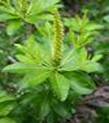| Kingdom | Plantae |
| Division | Magnoliophyta |
| Class | Magnoliopsida |
| Order | Euphorbiales |
| Family | Euphorbiaceae |
| Genus | Stillingia |
| Species | S. sylvatica |
| Binomial name | Stillingia sylvatica |
Other Common Names:
The other common names for the herb queen's root are silver leaf, sapium sylvaticum, yaw root, queensdelight, and cock-up-hat and nettle potato.
History

The plant was named after Dr B. Stillingfleet.The genus was monographed in 1951.Oil of stillingia is a fixed oil derived from the Chinese tree Sapium sebiferum, which was formerly classified as a species of Stillingia .Stillingia was used by the Eclectic medical movement and is an optional ingredient in the controversial Hoxsey cancer formula. 5, 6 it has also been used in homeopathy. Queen's-delight was once a popular home medicine and it's a native to a wide range of South America. They claimed that its root had many virtues: as a laxative, an emetic, an expectorant, blood purifier, and a treatment for syphilis.
Description
Queen's delight is a perennial herb growing to 4 feet tall. A milky-juiced plant with fleshy, crowded, leathery, stem.They have leathery, elliptical alternate leaves, about 1-3 inches long, are finely toothed and nearly stalkless.Leaves vary in shape some are round, others sawtoothed.Yellow flowers of queen's delight are petal less and occur in dense terminal spikes, with the male blossoms along the upper part of the spike and the female blossoms along the lower part.


Range
It occupies a wide range in Southern United States of America from Virginia to Florida and westward to Texas. It is also found in south eastern Colorado.
Habitat
It is found in sandy dry soil, pine barrens, old fields, and forest openings. The plant prefers light sandy, medium loamy and heavy clay soils. The plant prefers acid, neutral and basic alkaline soils. It can grow in semi-shade light woodland or no shade. It requires moist soil.
Cultivation
The root of queen's delight is unearthed after flowering has finished in July. Rootstock is harvested in August or September.
Flowering Season
The flowers are in bloom between May to July.
Pests and Diseases
No serious insect or disease problems. Crown rot can be a problem in wet, poorly drained soils. Susceptible to rust and leaf spot.
Parts Used
The most commonly used part of the herb Queen's delight is the roots.
Medicinal Applications

• Queen's delight helps in secretory functions and promotes general detoxification.
• It is used in treating skin diseases chronic bronchitis, laryngitis and leucorrhoea.
• It is often given for syphilitic complaints in place of mercury.
• Queen's delight is taken internally to help clear constipation, boils, weeping eczema, and tubercular infection of the lymph glands of the neck.
• It is applied in the form of a lotion to hemorrhoids and to itchy skin conditions such as eczema and psoriasis.
• A decoction has been used to treat bird sickness, diarrhoea, and vomiting and appetite loss in children and in adults.
• It has also been used to treat menstruation sickness, yellow eyes and skin weakness.
• The root has been used to treat the worst forms of venereal disease.
• It's used as a detoxifier, a laxative or an emetic.
This claimed for Good Luck in Love Affairs, Romance, Marriage, and Matters of Passion, this is the root to get, for it is superior to any other love-drawing fetish or amulet. It is widely said to attract and draw men. Women may sprinkle the root powder in their bath before going out with a man they love. They may also use it as a dust and sprinkle it in clothes.